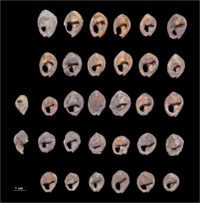 Archaeologists in Morocco have discovered a set of shell beads that date to between 142,000 and 150,000 years ago making the perforated shells the world’s oldest known jewelry.
Archaeologists in Morocco have discovered a set of shell beads that date to between 142,000 and 150,000 years ago making the perforated shells the world’s oldest known jewelry.
The 33 sea snail shells were unearthed excavations from 2014 to 2018 in the Bizmoune Cave less than 10 miles inland from the Atlantic coast of southwest Morocco. About a half-inch long, the shells are longer than T. gibbosula shells found at other sites in North Africa. The perforations are mostly natural holes that were chipped into ovals and circles. The edges of many of the holes are smoothed and polished, wear and tear from strings being threaded through the perforations. Residues of red pigment and ochre suggest that at least some of the shells were painted.
The beads serve as potential clues for anthropologists studying the evolution of human cognition and communication. Researchers have long been interested in when language appeared. But there was no material record of language until just a few thousand years ago, when humans began writing things down.
The beads, Kuhn said, are essentially a fossilized form of basic communication.
“We don’t know what they meant, but they’re clearly symbolic objects that were deployed in a way that other people could see them,” he said.
The beads are also notable for their lasting form. Rather than painting their bodies or faces with ochre or charcoal, as many people did, the beads’ makers made something more permanent, Kuhn said, suggesting the message they intended to convey was a lasting and important one.
The study has been published in the journal Science Advances and can be read here.